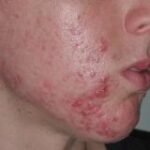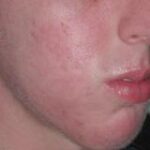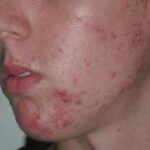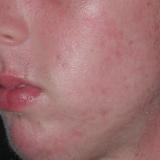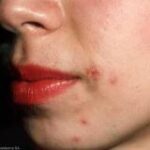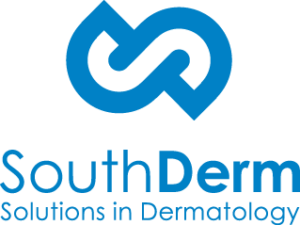Acne
Overview
Controlling acne is an ongoing process and can take time. Sometimes acne causes permanent scarring of the skin. This is more likely when the acne has not been successfully treated or when the acne has been present for a long time. Scarring can appear as flat red, white or brown marks, thickened scars, or as indented areas (pitting) of skin. The specialist dermatologists at SouthDerm, located at Kogarah, southern Sydney, have many years of experience in treating acne to reduce spots and minimise the chances of scarring.
Acne scarring can be reduced with several specialised techniques available at SouthDerm.
WHAT IS ACNE?
Acne is a very common skin condition that causes pimples. It develops when the pores (tiny holes in the skin) become blocked, allowing oil and bacteria to build up. This leads to the appearance of red spots, whiteheads or blackheads or lumps under the skin (cysts). Acne is most common in teenagers but can affect people of all ages. It also tends to run in families. Acne usually affects the face, neck, chest, shoulders and upper back, which are the areas with a high number of oil glands.
WHAT CAUSES ACNE?
Acne may be triggered by hormonal changes during puberty, pregnancy or the menstrual cycle. It may also be aggravated by stress, oil from the scalp and certain medications, including steroids. Some face moisturisers and oil-based make-up can make acne worse. Humid weather may also aggravate acne.
The role of diet in people with acne remains controversial. Acne is not caused by eating chocolate or greasy foods, but studies have linked diets that are high in sugar or dairy products with outbreaks of acne.
There are various treatments available for acne and acne scarring. The specialist dermatologists at SouthDerm can help. Click on the treatment tab at the top of this section for more information on acne treatments.
All medical and skin cancer treatments are carried out in our southern Sydney, Kogarah, skin cancer and cosmetic surgery clinic.
Treatment
HOW ACNE IS TREATED
Controlling acne is an ongoing process and can take time. The specialist dermatologists at SouthDerm have many years of experience in treating acne to reduce spots and minimise the chances of scarring. Options include:
- Non-prescription creams and lotions: these can help milder cases of acne, but can make the skin dry if used too often.
- Creams prescribed by your doctor: these can help to unblock the pores and reduce the bacteria on the skin.
- Oral antibiotics: taken by mouth for several months, antibiotics may reduce the growth of bacteria on the skin.
- Hormonal medications: the contraceptive pill and other hormone treatments may be used to treat acne in some women.
- Oral retinoids/vitamin A: these medications are very effective for the treatment of acne; they reduce the blockage of pores on the skin, making it more difficult for spots and infections to occur. They can only be prescribed by dermatologists. Isotretinoin (Roaccutane) can be provided for you at SouthDerm if your dermatologist feels it is required.
- Broadband Light Therapy (BBL): this technique uses pulses of light to attack the bacteria on the skin. Each treatment lasts for 20 to 30 minutes and is usually given once a week for several weeks.
HOW ACNE SCARRING IS TREATED
Sometimes acne causes permanent scarring of the skin. This is more likely when the acne has not been successfully treated or when the acne has been present for a long time. Scarring can appear as flat red, white or brown marks, thickened scars, or as indented areas (pitting) of skin.
Acne scarring can be reduced with several specialised techniques available at SouthDerm. These include:
- Laser skin resurfacing: using the ProFractional laser, this technique provides excellent results for some types of acne scarring. The laser makes thousands of tiny microscopic channels in the skin, causing the skin to regenerate new cells in a very even pattern, so that the scar tissue is smoothed out. The process leaves the surrounding tissue intact so that only the scar tissue is treated. Often one treatment is all that is required but sometimes two or three treatments may be necessary. The ProFractional laser can also be combined with other treatments including dermal fillers and scar excision.
- Fillers: acne scars often result in a loss a tissue volume beneath the scars, causing a hollow or indented appearance. Fillers are special materials such as collagen that can be injected under the skin to build up the tissue volume again, reducing the indented areas of skin. Once the skin has been held in the correct position it starts to adapt permanently, and fillers can last for several years.
- Subcision: this technique involves using fine needles to break up bands of scar tissue that are distorting and pulling on the skin. Separating the bands of scar tissue allows the skin to lift up to its correct position again. Subcision works well on indented acne scars. The procedure is often repeated every few months and can be combined with laser resurfacing.
- Scar excision: some types of acne scars, including deeply pitted scars and white scars, are managed by careful removal of the scar and stitching of the area. The process can be combined with laser skin resurfacing to further reduce the appearance of any remaining scar tissue.
- Punch grafting: some deeper scars may be treated with skin grafts. A tiny instrument punches a hole in the skin to remove the scar, and the hole is then ‘plugged’ with skin taken from elsewhere, often from behind the ear. The plugs are taped into place for several days while they heal. The process can also be combined with laser skin resurfacing to smooth out the new skin.
- Chemical and fruit peels: special chemicals or acids from fruit can be applied to the top layer of skin to remove the damaged cells and smooth out shallow or superficial acne scars.
Images
